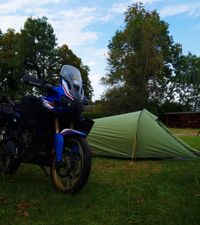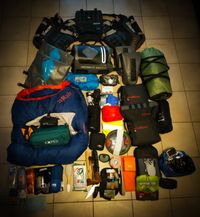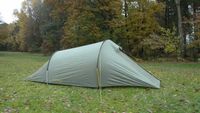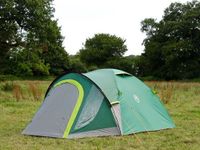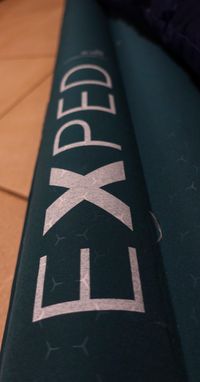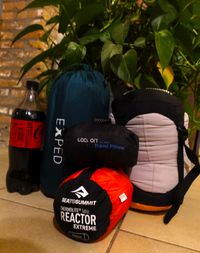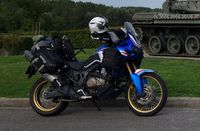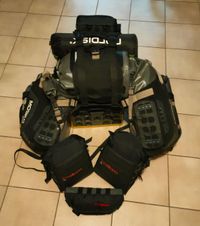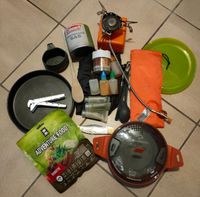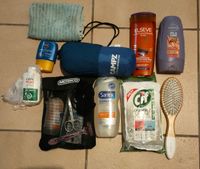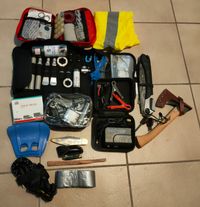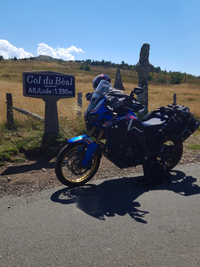Current Blog
Due to the length of this blog, it will be published in several parts the coming days. Stay Tuned!
10 February 2024 (Part 1.1)
Equipment and Adjustments.
When I got my license in 2008, I was happy with any motorcycle. The world of intensive adjustments to other specifications was completely foreign to me. I accepted the standard settings, put on the cheapest simple motorcycle suit and helmet, and then rode roughly 50,000 kilometers a year for the first few years. A combination of pleasure rides and many kilometers for my work.
In the past 10 years, this has changed, and I slowly started to explore the possibilities of making the motorcycle more my own. With the help of my husband, we searched for the settings that worked for me. So we started simply by replacing the original suspension with aftermarket parts, and the motorcycle became increasingly equipped with extras.
In the meantime, we have modified our motorcycles in such a way that this has significant effects/changes on the handling and comfort. From better suspension, shock absorbers, different clutch and brake levers to different footrests. The motorcycles have truly become ours.
For me, the motorcycle is not just for simple rides. The motorcycle has become part of the challenges I take on. One of those challenges is camping.
As a young child, I grew up with camping. My parents were very fond of camping, but it was always with a caravan. There was a kind of promotion system for us children. We started sleeping in the caravan. The first promotion was a sleeping spot in the awning, but the biggest promotion was being allowed to sleep in our own tent next to the caravan.
Camping has therefore been instilled in me to a certain extent from an early age. However, going on a trip and camping with the motorcycle is of a different order. I have been somewhat searching around on how to, and even now my basic equipment is still evolving.
Based on a lot of research and my personal experiences, I try to share some tips and tricks in this blog. Which will be in two parts. The first about equipment, the second about going on camping trips.
In essence, your camping equipment can be divided into three main areas:
- Shelter (for example, a tent);
- Sleep system (sleeping pad and sleeping bag);
- Storage system (for example, cases or bags).
There is an incredible amount of stuff available on the market. In all shapes and sizes. I will try to clarify the above points per component.
11 February 2024 (Part 1.2)
Shelter system
My personal preference is a tent. There are a number of points that I believe the tent must meet based on some personal trial and error experiences.
- Calculate with the number of people you are camping with a +1 extra. Why? For the space to store all your luggage (for example, your helmet and suit). So if you are alone? Choose a 2-person tent. If you are together? Then take a 3-person tent;
- Choose the tent that is most comfortable for you physically. Both in terms of setting up and sleeping. For example, a spacious tunnel tent or a self-supporting dome tent.
- Pay attention to the weight of the tent. The heavier the tent, the more it affects the total weight of your luggage, and the more it affects the handling of the motorcycle.
- My personal preference when I go camping alone ultimately fell on a tunnel tent from Nordisk (Halland 2 PU). The reason is a combination of weight (only 3 kilograms), quality, comfort for me as a small person, and the fact that the outer tent is set up first and then the inner tent. So if I have to set up the tent in the rain, the inner tent stays almost completely dry. Most tents have the system where you first set up the inner then and then the waterproof outer tent over it. When you set up in the rain, this often means that the floor of the inner tent gets wet. As a result, you often have to sleep in damp conditions.
- When my husband and I go on a trip together, we use a 3-person dome tent from Coleman. This offers a bit more comfort for my husband. This tent also has a dark inner tent, which is beneficial for my husband’s sleep. He can’t sleep well when it starts to get light. In terms of weight, this one is actually too heavy. Therefore, this tent will be replaced with an alternative in the future. But which one exactly we haven’t decided yet.
12 February 2024 (Part 1.3)
Sleep system
Here I always try to advise making the right investments. A poor sleep system can change your entire camping experience into a kind of “hell”.
- Start with the right sleeping pad. The most important factor here is mainly the insulation value. My advice is to choose a minimum insulation value of 5R. Sleeping pads from 1R to 4R are predominantly only suitable in the summer. With 5R, you usually have sufficient insulation for cold spring and autumn nights. Most of the cold comes through the ground, the sleeping pad, and then straight through your sleeping bag to your body. When you have a well-insulated sleeping pad, this already greatly reduces the cold during sleep.
- I chose the Exped Dura 5R Medium Wide. The wide is a slightly wider sleeping pad, which offers a bit more comfort but doesn’t really take up much more space.
Sleeping bags generally have two different types of filling. Synthetic filling and a down filling. Both have their pros and cons. For both, when you choose a sleeping bag, also pay attention to the comfort temperature rating. The limit temperature indicated on the sleeping bags is to help you survive in that temperature. Not to make you comfortable.
- Synthetic filling stays in place a bit better in the compartments of the sleeping bag. This is why sleeping bags with synthetic filling often have wider panels between the stitching. This means you often have less trouble with cooler edges because there are fewer stitching seams. However, a disadvantage is the pack size. A sleeping bag with a comfort temperature up to 0 degrees Celsius already has a serious pack size and can therefore quickly fill a whole pannier/bag.
- Down filling often has narrower panels between the stitching. This means you have cooler edges in the sleeping bag more quickly. The reason for this is that down does not stay in place as easily. However, an advantage of down sleeping bags is that they can be packed extremely small in a compression sack.
- My choice ultimately fell on a down sleeping bag from RAB. The Ascent 700 Women. This one is slightly shorter than most sleeping bags (suitable for a body length of 170cm) and has a bit more room at the hips due to the average body shape of women. To reduce the burden on the sleeping bag from the body’s influences, I also have the Sea to Summit Liner Extreme in it. This absorbs a lot of moisture and odors, which can also be used separately in the summer. For example, during very warm nights. When traveling you can simply leave the liner in the sleeping bag and pack it into the compression sack (also one from Sea to Summit because RAB’s is not really a compression sack).
Last but not least, it is important to have a pillow.
- Some are satisfied with a rolled-up sweater as a pillow. Still, I can always recommend also thinking carefully about this. After all, it is part of whether or not you get a good night’s sleep. There are also so many different types an sizes available. From inflatable travel pillows for literally a few euro’s to down pillows with a serious price tag. It all depends on your sleeping habits (for example, whether you are a side or back sleeper), your budget, and preferences. Take your time to find something that fits your wishes.
- My choice ultimately fell on the Cocoon Air Core Pillow Ultralight. Still packs very compactly, but the top lining provides a comfortable feeling. I can always find a place for this in my luggage.
Here the whole system packet compared to a 1 liter bottle:
13 February 2024 (Part 1.4)
Storage systems
This can generally be divided into two types. Each with its own pros and cons:
Hard luggage:
- The typical hard cases. These have the biggest advantage that they can be locked. Also, when packing, these are often easier to divide into smaller compartments to keep an overview. A disadvantage may be that they become poorly lockable when they have endured an accident. Safety can also be a concern. Mainly in accidents on unpaved roads where the hard cases can come onto the rider’s legs, with all the consequences that entails.
Soft luggage:
- These are available in all shapes and sizes. From simple side bags, roll bags tot systems that do not require a rack. An advantage of soft luggage is the flexibility it offers and the safety in the event of an accident. The risk of physical injury from soft luggage is considerably smaller. Also the problem of not being able to close them after an accident is much smaller. However, a disadvantage is that soft luggage cannot be locked. There are chains and special backpacking nets available, but it is not a waterproof system. Depending on the type of soft luggage, packing can also be a bit of a challenge.
- My choice fell on a combination of a Mosko Moto Reckless R80 and various bags from Turkana. The modular properties, a bit of safety during off-road riding, and the fact that I can easily switch the bags between different motorcycles made me prefer this. For me personally, not being able to lock is was not really an issue. When I’m on the road, I never leave my motorcycle, and thus the luggage, out of sight.
15 February 2024 (Part 1.5) Final part about equipment.
Others
Then, of course, all the other stuff comes along. Tools, sanitary, cooking set and everything in between. Personally, I may take too much with me, but this is partly due to the tour guides I do. Below is a quick overview of everything I take with me on the road.
Cooking set:
- A combination of a frying pan with clamp from Tangria and a 1 liter Xpot from Sea to Summit. Folded together, this set is about the size of a frisbee. To be able to cook, I use the Vango folding stove with a canister. The choice for gas is because I don’t camp in temperatures where I can’t light it and in areas where I can almost always find a canister in a store. Do you also like winter camping or riding in regions where availability is limited? Then a compression bottle for gasoline might be a better option. When this is empty, you can always transfer some from the motorcycle’s fuel tank in an emergency.
- Furthermore, I always have a plate with me (fits between the Tangria and Xpot) and a wooden spatula (doesn’t damage the pans). And off course a cultery set.
- Since my Preference is for freshly prepared food, I always have some salt, pepper, some other simple herbs, and oil with me for cooking.
- To clean everything, I have a small sponge and biodegradable detergent with me.
Sanitary needs:
- As a woman, this bag may be a bit more extensive than what most will take with them. In addition to a pack of wet wipes, the towel (microfiber because it dries quickly and packs very small), a small amount of toilet paper (for emergencies), deodorant, toothbrush and toothpaste, I also have shampoo, conditioner (very necessary for long hair), shower gel, hairbrush, small scissors and nail file with me.
Tools:
- I have enough tools with me to at least be able to repair a tire (both tube and tubeless), if necessary, loosen the brake calipers and fix leaks with, for example, tyraps, duct tape and kneadable metal. The tire spoons and sockets are from the brand Eastbound. This is because of the modular system which I really like and therefore also fits very compactly in my tool roll. The set is further supplemented with some small tools from MotionPro.
- For other tools, I have a sturdy knife, branch saw and a small hatchet with me. Furthermore I have a magnesium set and a stick of fatwood with me to be able to make a fire in care of emergency or just create a nice campfire.
- To have some light in the dark, I have a kind of mini maclite lamp with USB charger, which lasts quite a few hours. I’m still looking for a nice headlamp, but I haven’t made the choice yet which one is the most comfortable for me personally.
First aid kit:
- This set consists of materials that I know how to work with. From simple plasters to a sling, bandages, and everything in between. Then the set is supplemented with a foil blanket, stomach and intestinal medicines, and two different types of painkillers. This is because not everyone reacts very well to paracetamol of ibuprofen, and vice versa. Ultimately, the set is always to be able to create a stable situation in an emergency until the emergency services arrive to take over. Especially within Western Europe. When traveling to areas where the infrastructure around emergency services is more limited, think carefully about how you build up your set and follow courses that can help you in potential emergencies.
- In addition to my regular first aid kit which I can use for both my participants and myself, I also have my own medication with me. Including stronger anti-inflammatory drugs, medication for my asthma, and my custom-made MRA brace for my sleep apnea.
Ultimately it is different for everyone. Every person has his/her own preferences, wishes and challenges. Always take the time to find out exactly what you want. Compare various products within the same subject. Check it out step by step based on the properties that do or do not fit your wishes, ultimately ending up with the product that suits you as a person.
The next part of the blog will cover more tips and tricks for traveling and camping with your motorcycle in Europe.
